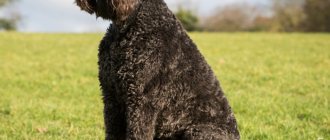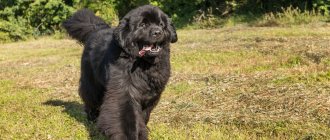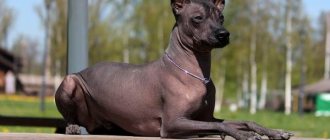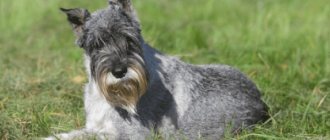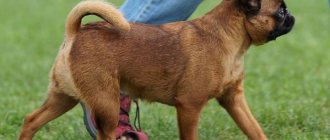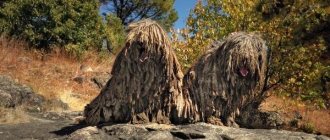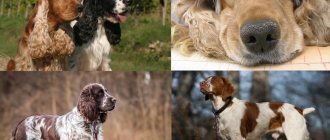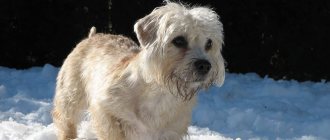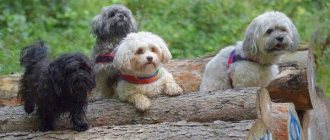The Catahoula dog is an animal with an unusual appearance and character. This variety amazingly combines the qualities of hounds and hunting breeds. Catahoula dogs are valued for their endurance, excitement, hunting instinct, keen sense of smell, agility and pursuit. The “calling card” of purebred representatives of the selection is their unusual coat color - leopard.
The dog needs an owner with a strong and fair character, who wants to have an excellent companion, a loyal friend and a sensitive game hunter nearby.
Care and maintenance
Caring for the beauty's short hair is easy.
It is enough sometimes, about once every seven days, to wipe it with a damp towel or just with your hand, which will be much more pleasant for the dog. Sometimes you can massage with a hard mitten. With this you will remove excess hair and scratch your pet’s sides. During the molting period, combing procedures should be carried out more often - 2-3 times a week. General recommendations, as for many dogs, are teeth, eyes, ears. Everything needs to be cleaned regularly. It is recommended to trim the nails if they do not wear down naturally. It is not recommended to keep a dog in an apartment, preferably in a private house, where there is an opportunity to spend a lot of time in the fresh air.
The ideal option is to live somewhere on a hunting property or on a farm. Where there is a job for her intended purpose. However, if you have a lot of time to walk with her for a long time, perhaps she will find it cozy in the apartment. They need to be occupied with gymnastics, training, and learn various commands.
By the way, they are big fans of digging in the yard. Stop such “exercises”, otherwise your entire territory will be in pits. And one more piece of advice - they don’t really like cold winters, because their fur is short, so it’s worth taking this factor into account.
Only a person who has some experience in cynology should own such a dog. Therefore, it is recommended to immediately contact an experienced professional. They have some health problems:
- Deafness is a genetic predisposition, usually affecting white dogs, and is associated with the presence of melanocytes in the body. Therefore, when choosing a dog, you need to make sure that there is some white in the color. These dogs have an 80% chance of being deaf or with one-sided hearing (directional deafness). Breeders euthanize deaf puppies. If both parents are Merle, their children have a 25% chance of being blind, deaf, or both. These puppies are called "double merle".
- Hip dysplasia is also a genetic disease, and also depends on the responsibility of the breeders. According to the Animal Orthopedic Foundation, approximately 20% of Catahoulas have this disease. It is necessary to take an x-ray on time and undergo an examination by a doctor.
Maintenance and care
As mentioned above, Catahoulas are not suitable for the role of lap dogs and it is better to keep him in a private house or on a farm. There there will always be a job or a favorite activity for him, and a happy, satisfied and tired dog will be docile and grateful. These animals do not require special care.
Short hair does not need to be combed and can only occasionally be cleaned of heavy dirt. Naturally, every owner is obliged to monitor the cleanliness and health of their pet, so as necessary, clean the ears, remove plaque, and have preventive examinations at the veterinarian.
As for diet, the leopard dog is not picky.
It is important that a large proportion of the food is fresh meat. It can be served either raw or cooked.
Porridge and vegetables are added to it. Choose lean varieties of meat, giving preference to poultry, rabbit, and beef. Give your pet a course of vitamins as needed or according to the season. They have good health and no genetic diseases. With proper care, they can live up to a maximum of fourteen years.
What to feed?
There are no special recommendations for feeding representatives of this breed. Of course, the diet should be complete and balanced according to BJU. Food is selected taking into account the age of the pet
You should pay attention to ready-made super-premium dry food designed for dogs with an active lifestyle.
Natural feeding is also allowed. In this case, the pet’s menu must include meat and offal. The proportion of such components is calculated as follows: 40 g per 1 kg of weight for young individuals and 10-15 g per 1 kg of weight for adults. The animals are also given cereals, eggs, and vegetables. Fermented milk products are also useful.
Character
The Louisiana Catahoula Leopard Dog has a strong, willful personality. Natural independence becomes more pronounced with age; pets are not prone to blind obedience. Proper upbringing from puppyhood makes animals more manageable; dogs learn clear boundaries of what is permitted and recognize rules if they do not interfere with the natural needs of the animal.
Dogs can only be kept by experienced owners who are familiar with the basics of canine training. Stubbornness and insubordination are characteristic manifestations of pets. Only specialists who know the psychology of animals will be able to direct their volitional qualities in the right working direction.
Dogs tend to make their own decisions. They do an excellent job of shepherding in difficult conditions. The determined four-legged helper can withstand physical stress perfectly and copes with control over the herd.
Security functions are well manifested only on the territory of the house, where the dog protects the home and its inhabitants
The Catahouls treat children very carefully and carefully and will always speak out in their defense. The animal is vigilant in its territory, which is helped by acute hearing and smell.
On foreign territory, the dog reacts to external stimuli and requires control, since strong hunting instincts prevail over the rules of behavior even in well-bred pets. They have little tolerance for small animals, such as cats and toy dogs.
The character of the Catahoula leopard dog makes it possible to become a faithful companion and family friend. Kindness and playfulness are manifested in response to a peaceful atmosphere of upbringing, patience, and care.
In the owner, the animal must feel the leader in consistent demands and persistence. The dog needs to be given enough time to raise a responsible worker and a loving family member. The key to a good relationship should be respect for the pet.
Historical reference
There is no exact information about the origin of the breed yet, but many myths and legends are associated with the Catahoula dog. There is a belief that in ancient times these dogs accompanied the Choctaw Indians who lived on the shores of Lake Catahoula. That is why the breed got its name, which translates as “clean lake”.
The Louisiana Leopard Dog is a charming pet with a difficult temperament.
Note! It is believed that the name of the breed was given in honor of the amazing sky-colored eyes of these dogs. The first written mention of the breed dates back to the 16th century.
Modern dogs are the result of a complex crossbreeding of aboriginal representatives and French herding Beaucerons. At the beginning of the 20th century, the breed was brought to the brink of extinction, but through the efforts of breeders it was saved. In 1951, fans of the breed founded the National Louisiana Catahoula Dog Association. A breed standard was formulated, and since 1979 these dogs have taken part in international exhibitions. However, they have not yet received recognition from the International Canine Federation
The first written mention of the breed dates back to the 16th century. Modern dogs are the result of a complex crossbreeding of aboriginal representatives and French herding Beaucerons. At the beginning of the 20th century, the breed was brought to the brink of extinction, but through the efforts of breeders it was saved. In 1951, fans of the breed founded the National Louisiana Catahoula Dog Association. A breed standard was formulated, and since 1979 these dogs have taken part in international exhibitions. However, they have not yet received recognition from the International Canine Federation.
Interesting Facts
Here are some unusual features of Catahoula dogs:
- They have an amazing memory, but are stubborn. Therefore, the fight against behavioral defects should begin at an early age.
- Puppies mature quickly and at 9 months they become similar in appearance to adult dogs.
- They are just as quickly able to engage in the activities intended for them. Catahoulas are universal dogs, suitable for hunting, guarding, and being a companion - they approach everything responsibly.
- They love to swim and do it well thanks to the membranes between their toes.
Amazing color and stunningly beautiful blue eyes are the strengths of this breed.
Description of the breed
The Catahoula leopard dog belongs to the hunting breeds (thus, it is assigned to the 6th group “Hunting” according to the classification of the United Kennel Club). According to the UKC standard, representatives must have the following characteristics:
- a powerfully built head, when viewed from the side, the skull and muzzle are approximately equal in length;
- the planes of the upper line of the skull and muzzle are parallel to each other;
- the skull is wide and flat, with well-developed cheeks;
- the muzzle is strong, slightly tapering towards the nose;
- lips are either pulled up or droop a little, but can be of any color;
- eyes of medium size, round, of any color (heterochromia - eyes of different colors are allowed) or a combination without identifying a preferred color;
Catahoula dogs are allowed heterochromia - different colors of the iris of the eyes.
- teardrop-shaped ears (folded into a triangle), short or medium length, proportionally wide at the base and tapering towards the tip;
- muscular, not too long neck;
- the forelimbs are straight, making up approximately 50–60% of the dog’s height at the withers, and the hind limbs are well bent at the knee joints, oval-shaped paws;
- the body is slightly elongated, it is longer in length than in height at the withers;
- the back is muscular, the chest is deep and wide;
- the tail visually continues the line of the back, tapering towards the end.
The leopard dog has drooping ears, a fit body and a strong muzzle.
In adulthood, the ideal height for males is 60-61 cm, and for females - 55-56 cm. The dog's weight should be from 23 to 43 kg in proportion to height. The Catahoula must be powerful, but energetic and free in her movements. The trot moves smoothly, smoothly, without any effort, and as speed increases, the legs move toward the center line of balance. When walking and running, the limbs should not turn anywhere or interfere with each other.
Coat and colors
The coat that covers the Catahoula dog's body can be short or medium in length, lying close to the body, with a smooth or coarse texture. As for color, there are many variations of color combinations possible, but there are a number of mandatory rules:
- any color combination (other than a solid color) must have a dotted pattern or stripes on the chest, cheeks, above the eyes, on the legs, under the tail;
- a contrast between the base color and the design itself is required;
- There may be several variants of the pattern on the fur: leopard (with dots);
- tiger (with stripes);
- flaps (spots of different colors and sizes, perhaps even without the predominance of one main one).
No one color or pattern is considered preferable. Only more than 70% white is considered a big minus.
The variety of colors of a leopard dog is amazing - the coat can be either plain or have a pattern in different color combinations
Character and psyche of the breed
Catahoulas are a freedom-loving and independent dog, which in some cases will make decisions on its own, without listening to the wishes of its owner. Behavior completely depends on the situation: when hunting, it is a serious and businesslike dog, busy with its own business, and at home it is a playful pet. Despite their craving for independence, Catahoula dogs clearly understand their place in the family and are affectionate, gentle members of it. The breed was bred as a hunting breed, so there is not much tolerance for other animals, especially small ones. Dislike for cats and small breeds of dogs is especially pronounced in females. Even excellent upbringing is not always able to prevail over strong instincts, so it is better if the leopard dog is the only pet.
The key to a successful relationship with a Catahoula dog is respect and an established connection. The pet will not tolerate screaming, aggression, or physical abuse. A person without experience is unlikely to cope with an animal; in raising it, you will have to clearly set boundaries and adhere to the stated rules. Only with proper training and care will a rare breed dog become both a loving family member and a responsible employee.
Disadvantages and disqualifications
Any deviations from the standard are considered disadvantages:
- too wide or narrow skull;
- incorrect shape or type of ear;
- short, thin or thick neck;
- thicker forelimbs than hind limbs;
- malocclusion (overbite or underbite);
- uncentered pupils;
- dysfunction of the eyelids, due to which the eyes are closed;
- too small or heavy bone, etc.
The reason for removing a representative of the breed from exhibition and breeding activities will be serious shortcomings, clearly described in the standard:
- cropped ears;
- shyness or aggressiveness;
- deafness (in one or both ears);
- a tail curled into a ring or its complete absence;
- long wool;
- more than 90% white coat color;
- albinism;
- solid white head.
Price
First, let's introduce the disqualifying qualities of this breed:
- Excessive aggression or extreme shyness.
- Unilateral/bilateral cryptorchidism (not descending of the testicle into the scrotum, location of the testicles outside the scrotum).
- Unilateral/bilateral deafness.
- Long and/or fluffy coat.
- More than 90% white; completely white head; albinism (completely white);
- Complete absence of tail;
- Cropped ears.
The dog you choose should not have all these shortcomings. This breed is quite rare outside its homeland, so it is necessary to choose a reliable nursery or a trusted breeder.
Catahoula leopard dog kennels are located mainly in America, Germany, the Czech Republic and some other countries. The price of a Catahoula leopard dog officially starts at $1,000, although in fact many kennels offer no less than $1,200.
Don't forget about shipping costs. Taking into account all expenses, a dog can cost you 1500-1600 dollars. It would not be superfluous to remind you that when purchasing, you should check all the documents for the dog, including the colors of the parents, and the presence of vaccinations.
Origin story
The history of the Catahoula leopard dog dates back to the 16th century. In 1539, the Spanish conquistador Hernando de Soto began his campaign of conquest in North America, landing on the coast of Florida. An integral part of any such “expedition” were dogs. They were used for hunting and as war dogs against Indians. De Sota was mainly accompanied by greyhounds, ancestors of the Spanish galgo, and the mastiff-like Alan dogs. Three years later, the conquistador died in Louisiana from fever. The remaining soldiers decided to return to Spain, leaving many of their dogs behind. Subsequently, they were used by the Indians for hunting.
In 1979, the breed was declared the official state symbol of Louisiana.
It is known that around this time a red wolf was roaming around the Indian camps in search of food. Periodically, he contacted the dogs. The Indians used hybrids to hunt wild boars and deer in the swamps of Louisiana. 100 years later, French settlers arrived here and brought their dogs, mostly the ancestors of the Beauceron. They started breeding them with local “half-wolves”. This led to the emergence of a population of dogs that became the progenitors of the breed. For a long time they were known as the Catahoula Hound, but in 1979 they were renamed the Louisiana Catahoula Leopard Dog by Governor Edwin Edwards. The breed is still not recognized by the FCI, only by the United Kennel Club (UKC) in 1995.
Purpose
The Catahoula Leopard Dog has an innate hunting instinct, which, along with the desire to please the owner, makes it a wonderful hunting assistant. Unlike other hounds, the Catahoula only follows a hot scent left about an hour ago, very rarely a scent two hours ago. It tracks game in silence, occasionally barking out of excitement, but then remains silent again. Having discovered prey, it barks, which allows the hunter to determine where the dog is. When hunting, the Catahoula remains within reasonable proximity of the owner. Uses both bottom and top sense. The work is universal, but primarily focused on the prey of animals: squirrel, raccoon, lynx, bear, wild boar and deer. It holds a large animal in place until the hunter arrives; it usually does not enter into a fight with it.
The Catahoula is not a herding breed in the true sense of the word, but can be used on a farm to herd cattle. Has his own working style. The Catahoula moves around the herd, forming a wide ring and holding it in place. If it is necessary to stop the animal, it will bark or bite in the nose area, but will not “hang” on the cow.
The Catahoula can be a wonderful companion and family dog. Capable of guarding and protecting. She has a very keen sense of smell and good learning abilities, but is poorly suited for the operational search service. Possessing a strong hunting instinct, she is too susceptible to other stimuli. The leopard dog can be seen at sporting events. The most suitable discipline is coursing, but Catahoulas also participate in agility, obedience and others.
Video about the Catahoula Leopard Dog breed:
Job
Hunting
Catahoulas are used as bay dogs, tree dogs, and for hunting a variety of game, including small game such as raccoons and squirrels, as well as large game such as deer, mountain lions, and bear. They are also used for scent-catching and as a search and rescue dog.
Herd
Catahoulas have a natural herding instinct and a unique way of working with the herd. The AKC describes this as creating a "dog fence" around the herd, which allows the dog's owner to control the herd within that circle. Herding ability and natural working instinct are the highest priority for Catahoula breeders, in addition to the dog's appearance. Herding instincts and learning ability can be measured using non-competitive tests. Catahoulas exhibiting basic herding instincts can be trained to compete in cow/pig trials.
Life expectancy and major diseases
Unfortunately, due to long-term inbreeding, as well as the common merle color, which dog breeders around the world hate, leopard dogs often develop serious illnesses.
- Joint dysplasia is an eternal companion of all large dogs, especially with poor nutrition.
- Deafness is a common genetic disease, especially common in dogs whose color is predominantly white. It can be either full or directed.
- Blindness - usually occurs in dogs whose both parents were merle colored - here the risk is at least 25%.
Note! Life expectancy is fairly standard for large dogs - an average of 12-14 years. However, good or negative care, feeding and attention to health can either increase or decrease this period. However, good or negative care, feeding and attention to health can either increase or decrease this period.
However, good or negative care, feeding and attention to health can either increase or decrease this period.
Gallery Edit
| Dog breeds |
| Australian Short-tailed Cattle Dog • Australian Shepherd • Australian Heeler • Australian Cattle Dog • Australian Kettle • Australian Terrier • Azawakh • Aidi • Alabai • Alano • Alpine Dachshund • American Water Spaniel • English Bulldog • English Coonhound • English Springer Spaniel • Appenzeller Mountain Dog • Affenpinscher • Greater Swiss Mountain Dog • White Swiss Shepherd • Barbet • Bergamasco Shepherd • Bichon Frize • Beauceron • Catahoula Bulldog • Buryat Mongolian Wolfhound • Welsh Corgi • West Highland White Terrier • East European Shepherd • Havanese Bichon • Gampr • Dutch Smoushond • Blue Gascony Basset • Dalmatian • Dandie Dinmont Terrier • Doberman Pinscher • Longhaired Collie • Drathaar • Eurasier • Wire Fox Terrier • Golden Retriever • Irish Water Spaniel • Yorkshire Terrier • Cane Corso • Kerry Blue Terrier • Cairn Terrier • Cromforlander • King Charles Spaniel • Shorthaired Collie • Komondor • Kuvasz • Kurzhaar • Labrador Retriever • Langhaar • Lhasa Apso • Mallorcan Shepherd • Maltese • Miniature Schnauzer • Pug • Moscow Watchdog • German Boxer • Auvergne Pointer • Otterhound • Puggle • Pekingese • Pyrenean Shepherd • Poodle • Puli • Pumi • Samoyed • Saint-Germain Braque • Slovakian Dude • Dachshund • Husky • Hovawart • Croatian Shepherd • Miniature Schnauzer • Chinook • Chihuahua • Swedish Lapphund • Shih Tzu • Sheltie • Sholoitzcuintle • Entlebucher Mountain Dog • Estrela Shepherd • Jagdterrier • Japanese Chin |
Character
These animals show aggression only during hunting, under the close control of the owner and direct it towards the specified game. In ordinary life, increased excitability or rigidity of character can be considered a vice. At the other extreme, a recognized reason for rejection is excessive cowardice or shyness. They are very playful and cheerful and need constant activity and work.
Do not forget that this is, first of all, a working dog, called to serve its owner and throughout its centuries-old history, it has performed exactly this task. For this reason, it is not recommended to have a Catahoula as a lap dog.
In a confined space, the animal's temperament will deteriorate sharply, since it will not be able to get an outlet for the accumulated energy. Even regular walks will not correct the situation. It is one thing to be in constant training mode, to chase game in the forest, to perform the work of a guard and even a shepherd, and quite another to lie on a rug in an apartment, waiting for the owner to return from work, and then take an evening exercise around a residential area in a collar and on a leash.
But they are perfectly trainable, do not try to gain a leading position and unquestioningly give their owner the leading role. But at the same time they have a rather stubborn character. Catahoula training should be carried out by experienced specialists; for beginners this activity will be beyond their capabilities.
You cannot show aggression or punish the dog for not following orders. Such behavior on the part of a person can cause aggression or affect the pet’s future relationship with its owner. Depending on the chosen line of training, a Catahoula can make either an ideal hunter or a vigilant shepherd.
As for behavior in the family, this is a very faithful and devoted friend. He gets along well with children over seven years old. He will be indifferent to very small crumbs. Usually attached not to one owner, but to the whole family at once. It can be used as a guard
Treats strangers with caution and distrust. He needs to communicate with people, but does not show it intrusively
Feeding
This rare dog is not capricious and picky about food, so the owner can decide for himself what he will feed his pet - ready-made industrial food or natural food
In the first case, products ranging from super-premium are purchased; it is important to provide the pet with round-the-clock access to clean water
In the second, food is prepared in a separate pan individually for the dog; it is unacceptable to give it the same thing that the owner eats. It is difficult to provide your pet with all the necessary vitamins and minerals in natural form with this feeding option. Therefore, the animal is additionally given ready-made complexes. A veterinarian can help you choose a specific vitamin name.
You can give your dog:
- Boiled or raw, but pre-frozen lean meat.
- Offal (heart, liver, kidneys).
- Sea fish (necessarily cleaned of scales and bones).
- Vegetables and fruits as sources of vitamins.
- Porridge.
Note! Meat should make up 70% of the diet. You should not give your pet cheap, economy-class food, even occasionally. The Catahoula gastrointestinal tract is not adapted to digest them, so the risk of problems with the digestive system increases
It is also unacceptable to treat your dog with sausages, frankfurters, sausages, cutlets and other human delicacies. Sweets, pastries, pasta, soups prepared with salt and spices are also prohibited. And, of course, alcohol - it should not be given even in tiny quantities.
Catahoula's gastrointestinal tract is not adapted to digest them, so the risk of problems with the digestive system increases. It is also unacceptable to treat your dog with sausages, frankfurters, sausages, cutlets and other human delicacies. Sweets, pastries, pasta, soups prepared with salt and spices are also prohibited. And, of course, alcohol - it should not be given even in tiny quantities.
You should not give your pet cheap, economy-class food, even occasionally. Catahoula's gastrointestinal tract is not adapted to digest them, so the risk of problems with the digestive system increases. It is also unacceptable to treat your dog with sausages, frankfurters, sausages, cutlets and other human delicacies. Sweets, pastries, pasta, soups prepared with salt and spices are also prohibited. And, of course, alcohol - it should not be given even in tiny quantities.
The look of Catahoula touches the soul, the owner is ready to give the dog his favorite treat at least every hour
Breed dossier
- Country of origin: Portugal.
- Classification: this is a breed of dog of the Molosser section of the Great Dane class
- Training: Azorean Cattle Dogs must be well trained at a very early age.
- Color: Fawn color, grey, light yellow, dark yellow.
- Sizes: Height up to 60 cm (23.6 inches) at the withers and 35 kg (77 lb) in weight, slightly less in females.
- General Impression: Zorsky Cattle Dogs should be well trained at a very early age if they are to be used as a pet, and be able to control themselves when around strange children or other irritants.
- Usage. The breed was originally used for working cattle.
- Physical activity: These dogs do not tolerate inactivity and aimless pastime.
- Personality: Large, aggressive, working dogs
- : Azorean dogs are accustomed to spending their entire lives outdoors and living in apartments and houses is not for them. If there is a large area for movement near the house, and the dog is sufficiently busy with work, then it feels quite good. Grooming: Short hair does not require special care.
- Amenable: This breed forms a deep bond with its owner, being very gentle, loving and receptive, but despite this, they are aggressive towards strangers and other dogs.
- Diseases: Azores Cattle Dogs from Portugal have no documented health problems, but when the dogs are bred elsewhere they may suffer from elbow problems, hip dysplasia and other diseases such as those related to breasts
- Diet:
- Lifespan: live 12-15 years.
Work
Hunting
Catahoulas are used as bay dogs, tree dogs, and for hunting a variety of game, including small game such as raccoons and squirrels, as well as large game such as deer, mountain lions, and bear. They are also used for scent detection and as a search and rescue dog.
Herd
Catahoulas have a natural herding instinct and a unique way of working with the herd. The AKC describes this as creating a "dog fence" around the herd, which allows the dog's owner to control the herd within that circle. Herding ability and natural working instinct are the highest priority for Catahoula breeders, besides the dog's appearance. Herding instincts and learning ability can be measured using non-competitive tests. Catahoulas exhibiting basic herding instincts can be trained to participate in cow/pig trials.
When and how was the leopard dog bred?
The first mention of the breed dates back to the 16th century. An expedition of the Spanish conquistador Hernando de Soto landed near the Catahoula River (or “sacred lake”) in Louisiana (USA). People traveled with dogs, which they used as fighting dogs and hunters. Three years later, Hernando died and his soldiers returned to Spain. Some dogs were left in America, where the Indians used them for their own purposes. History mentions that red wolves often crossed with representatives of this breed, which was the reason for the appearance of “half-wolves.”
100 years later, French settlers arrived in Louisiana with their four-legged friends, many of whom had Beaucerons as ancestors. As a result, the Catahoula breed combines the qualities of mastiffs, bloodhounds, beaucerons and greyhounds. In 1979, the state governor named the breed after the river and announced a new symbol of Louisiana. From now on, they were leopard dogs, which helped many times during search and rescue operations.
Interesting Facts
- Sometimes this breed of dog is said to be “the fiend of hell.” They mainly earned this nickname because of their unusual icy eyes. But not only. In pursuit of the beauty of the “leopard” coat, unscrupulous breeders crossed merle dogs indiscriminately, resulting in puppies with a very unstable psyche, angry and uncontrollable. But they were not to blame for this, people spoiled them.
- It is known that Theodore Roosevelt, the 26th President of the United States, had great respect and trust in the Catahoula breed. He only used them when hunting and often fell asleep with this dog at his feet.
- In Winnfield, Louisiana, an event featuring the Catahoula Leopard Dogs is held annually on the third weekend in March. They are called "Uncle Earl's Hog Dog Test." In addition to leopard dogs, other hunting dogs take part there. Uncle Earl is one of the most famous governors of Louisiana, Earl Kemp Long, who lived in the early 20th century. He was an avid hunter and promoter of the Catahoula Leopard Dogs.
- In 2007, the Catahoula was adopted as the school mascot for Louisiana Centennial College.
- Catahoula is a dog for tracking and keeping in place the prey. She does not go into a direct attack, since often the hunted animal can be much larger than her. Therefore, Catahoula bulldogs appeared in Australia and the southern United States - a breed resulting from crossing hunting dogs and American bulldogs. This dog has the best qualities of both breeds. He is capable of both tracking and attacking.
Pros and cons of the breed
The advantages of a leopard dog include short hair that does not require special care, alert behavior and sensitivity. The dog is an excellent hunter and devoted protector, but only within his home territory.
The hunting habits of the animal are closely related to territorial boundaries, and this is a minus of the breed. Outside the yard, the dog’s attitude towards others changes dramatically - he is peaceful, playful and good-natured towards every passerby.
In relationships with other pets, the Catahoula will not be able to contain its excitement. He will constantly hunt small domestic animals - cats, hamsters, ducks, geese, rabbits.
Characteristics
| Attachment level | Average |
| Friendliness | Average |
| Child friendly | Average |
| Loyalty to other pets | Short |
| Exercise needs | High |
| Playfulness | High |
| Energy level | High |
| Learning ability | Average |
| Intelligence | Average |
| Tendency to bark | High |
| Shedding amount | Average |
Description and features
The appearance of the Catahoula leopard dog (hereinafter referred to as Catahoula) creates the impression of an agile and hardy animal. They are usually medium or large in size (depending on the breeding line). There should be no excesses in the figure, neither heaviness nor excessive lightness.
Strong, moderately lean and harmonious physique. By the way, the appearance of a dog is assessed from the point of view of its influence on its working qualities. She was bred for her temperament and ability rather than her appearance. Therefore, the sizes of these dogs can vary significantly, with boys always being larger than girls.
Height ranges from approximately 51 to 66 cm, weight from 18 to 51 kg. A properly built dog is longer than tall. The spine is strong, the loin is slightly arched. The chest is moderately wide, the croup is slightly sloping. The head is large, but not excessively, in accordance with the size of the body. The jaws are strong, with a scissor bite.
The coat should be short or medium length, and can be soft to the touch or rough. Single, without undercoat, close to the body
When describing the appearance of a Catahoula, special attention should be paid to the eyes. It literally takes your breath away when you look at them.
They fascinate and freeze.
The eyes are one of the most interesting elements of this breed. Their color can be a shade of "cracked glass" or "marble glass". This happens with heterochromia (eyes of different colors or different colors of different parts of the iris in one eye).
Cracked glass or marble eyes that are Catahoula blue or blue-white are often called "double glass eyes." They may have both dark and lighter areas. There is a division in half on one iris - half of one color, half of another. Sometimes there is simply a stripe or spot of a different color.
Gray eyes, for example, are marked by blue and green areas, which create the gray color. The eyes can be the same color, or there can be two different eyes. In general, a kind of mosaic picture that is not always predictable. There is no specific standard, there can be gray, green, blue, light blue, amber, brown colors in different combinations.
The tail is often long and can reach the hock joints. Sometimes, on the contrary, it can be a shortened bobtail type (length from one to three vertebrae in total length). The long one is usually curved at the bottom in the shape of a question mark - a distinctive feature of the Catahoula tail. There is often a white tip on the tail. Short tails are a genetic heritage of the breed and are very rare.
The legs of the Catahoula are slender, quite long, and have a pronounced membrane between the toes. This makes it easier for them to hunt in the swamp and gives them the opportunity to swim well. The Catahoula leopard dog in the photo is very beautiful. Gracefulness, innate nobility, beautiful coloring and unusual crystal eyes - all this makes the breed memorable and desirable.
Historical reference
There is no exact information about the origin of the breed yet, but many myths and legends are associated with the Catahoula dog. There is a belief that in ancient times these dogs accompanied the Choctaw Indians who lived on the shores of Lake Catahoula. That is why the breed got its name, which translates as “clean lake”.
The Louisiana Leopard Dog is a charming pet with a difficult temperament.
Note! It is believed that the name of the breed was given in honor of the amazing sky-colored eyes of these dogs. The first written mention of the breed dates back to the 16th century.
Modern dogs are the result of a complex crossbreeding of aboriginal representatives and French herding Beaucerons. At the beginning of the 20th century, the breed was brought to the brink of extinction, but through the efforts of breeders it was saved. In 1951, fans of the breed founded the National Louisiana Catahoula Dog Association. A breed standard was formulated, and since 1979 these dogs have taken part in international exhibitions. However, they have not yet received recognition from the International Canine Federation
The first written mention of the breed dates back to the 16th century. Modern dogs are the result of a complex crossbreeding of aboriginal representatives and French herding Beaucerons. At the beginning of the 20th century, the breed was brought to the brink of extinction, but through the efforts of breeders it was saved. In 1951, fans of the breed founded the National Louisiana Catahoula Dog Association. A breed standard was formulated, and since 1979 these dogs have taken part in international exhibitions. However, they have not yet received recognition from the International Canine Federation.
Interesting Facts
Here are some unusual features of Catahoula dogs:
- They have an amazing memory, but are stubborn. Therefore, the fight against behavioral defects should begin at an early age.
- Puppies mature quickly and at 9 months they become similar in appearance to adult dogs.
- They are just as quickly able to engage in the activities intended for them. Catahoulas are universal dogs, suitable for hunting, guarding, and being a companion - they approach everything responsibly.
- They love to swim and do it well thanks to the membranes between their toes.
Amazing color and stunningly beautiful blue eyes are the strengths of this breed.
Kinds
Catahoulas come in a variety of colors including blue merle, red merle, brindle and solid colors. Merle is a coat with uneven coloration in the form of dark and lighter areas of the same color. The result is a “marbled” look. Sometimes the more permanent color is "sprinkled" with patches of other colors, such as white patches on the chest, legs or face.
Actually, the “merle” gene is responsible for the “leopard” color of the dog. Moreover, it happens that it manifests itself especially clearly not on the entire coat, but in certain places. We will present to you the most popular colors of the Catahoula dog, although we repeat that coat color is not a priority when choosing a dog; it does not affect its quality in any way.
- Red Leopard - Various shades of brown, sometimes with small white spots. Known as "red merle".
- Blue leopard - various shades of gray, from light to black, sometimes with rare white spots. Known as "blue merle".
- Black or black leopards are the least affected by the merle gene, but still have blue or gray spots.
- Gray or silver leopard is a blue leopard where the black color has been diluted to gray. Known as "merle slate".
- Tri-color - usually three colors are involved - black, gray, white.
- Four-color or five-color - dogs with different colors, brown and blue of different shades are added to the three main colors.
- Patchwork are predominantly white dogs with a small amount of merle spots throughout their coat. They can be black and brown. If you breed these merles further, you can achieve grey, blue, red or liver colors in them.
In addition to colors, it is appropriate to talk about the breeding lines of this breed, on which the size of dogs of this breed depends. There are three similar lines:
- The Wright line is the largest line of Catahoulas, weighing 40 to 50 kg, and was designed by Perston Wright. This line were specimens originally produced from dogs that arrived with Hernando de Soto (16th century Spanish conquistador, conqueror of the New World).
- The Fairbanks line is the next largest, weighing 30-35 kg. Was developed by Mr. Lavi Fairbanks. They were different shades of yellow, including brindle.
- McMillin Line. This blue glass-eyed Catahoula, measuring approximately 50 pounds, was developed by Mr. McMillin of Sandy Lake, Louisiana.
These three lines were the progenitors of all variations of Catahoulas known today.
Appearance
As working dogs, Catahoulas were bred primarily for temperament and ability rather than appearance. As a result, the physical characteristics of Catahoulas vary somewhat.
Size
Catahoulas can vary greatly in size, although males are on average slightly larger than females. Typical height ranges from 20–26 inches (51–66 cm) and weight ranges from 40–112 pounds (18–51 kg).
Physical Description
Although physical characteristics vary, Catahoulas are typically muscular dogs with a rectangular body. They have a large head with floppy ears and a strong, slightly pointed muzzle. They typically have a thick, muscular neck and a long, curved tail. They come in different colors and have medium/short hair.
color
Red merle Catahoula leopard with a litter showing a wide range of coat colors including double merle
Catahoula leopard dog, blue leopard color.
Catahoulas come in a variety of colors, including blue merle, red merle, brindle and solid. Often hard-coated Catahoulas have small patches of a different color, such as white, on the face, legs, or chest. The leopard coat of most Catahoulas is the result of the merle gene. The merle gene does not usually affect a dog's entire coat, but dilutes the color only in those areas that randomly represent the gene's characteristic. Deeper colors are preferred; It is not recommended to wear predominantly white coats. Since the Catahoula is a working dog, coat color is not a priority.
- Red Leopard:
These are various shades of tan and brown, and can also be white. Known as "red merle" in other breeds. - Blue Leopard:
These are various shades of dark gray, often with black, and some may also have white (usually on the feet and chest). Known among other breeds as the Blue Merle. - Black
or
black leopard
: These are the leopards least affected by the merle gene and show smaller areas of blue or gray. - Gray
or
silver leopard:
blue leopards where the black color is diluted to gray. Known among other breeds as the "slate merle". - Tri-color:
Has three different visible colors, usually white, black and gray. - Four-color and five-color:
have different body colors and trim colors. Gray Catahoulas can be considered four-color when included in white and brown trim. This dog may have black, grey, white (usually around the neck, muzzle, paws and tail) and tan (which can also appear around the muzzle and feet). - Patchwork:
Predominantly white dogs with small solid and/or merle patches appearing throughout the coat. The colored spots may be black or brown. Dilution can affect these colored spots and cause grey, blue, red or liver coloration within them.
Coat
The Catahoula has a single smooth short or coarse medium coat. The short looks almost drawn on. The medium may have extended "feathering" on the hind legs, tail and chest.
Eyes
The breed can have any eye color or combination of colors, including blue, brown, green or amber. Catahoulas are known for having heterochromia, which can lead to a number of different eye changes:
- Glass eyes
are very light, almost white. - cracked glass or marbled glass eyes
- when one eye contains both colored and glass parts, usually blue and brown. - Double Glass Eyes
- Catahoulas with two cracked glass or marbled glass eyes. - Spots
are spots of “glass” in the eye or color in the eye. The spots usually occur on brown eyes with glass spots or blue eyes with brown spots. - Gray eyes
are usually cracked glass eyes made of blue and green, giving them a grayish appearance.
Tail
The Catahoula tail can be long and whip-like, reaching to the hocks of the hind legs, or a bobtail, which is a tail that ranges in length from one vertebra shorter than the total length to only one vertebra total length. The bobtail is a rare but natural part of the Catahoula heritage.
Legs
Although most dogs have webbing between their toes, Catahoulas have more noticeable webbing on their feet, extending almost to the tips of their toes. This foot gives Catahoulas the ability to work in marshy areas and gives them excellent swimming skills.
Caring for a Leopard Dog
Caring for a dog of this unusual breed has specific features only in training, but daily procedures and feeding are standard.
General care
The short and dense coat of a leopard dog does not require complex care; it will be enough to comb it with a brush 2-3 times a week to remove lost hairs. Bathing is done as needed, and if it is slightly dirty, you just need to wipe the fur with a damp cloth. No haircut required.
After walks, especially after a hunt, it is important to inspect the dog for ticks, check the eyes, ears and paws for cuts, stuck debris, twigs, etc. Provided regular active walking, the nails do not require trimming - they will comb themselves to an acceptable length
Feeding
As with other breeds, there are two types of diets available for Catahoula leopard dogs: store-bought and natural.
In the case of industrial food, in addition to quality (super-premium and holistic class), you need to pay attention to the purpose of the product - it should be created specifically for active large pets (Acana Adult Large Breed, Royal Canin Sporting Life Agility Large Dog, Hills Performance)
Catahoula dogs will need food for active large breed pets
A natural diet should be prepared by a professional - only a balanced, properly assembled menu will provide the dog with the necessary energy and nutrients. It must necessarily include:
- lean meat (beef, turkey, chicken);
- sea fish fillet;
- eggs;
- vegetables and unsweetened fruits;
- low-fat dairy products
You should completely avoid flour, smoked, sweet, pickled, spicy and other dangerous foods. Also, tubular bones and fish bones should not be included in the diet - they can seriously injure the digestive tract.
Training
Aggression among representatives of the breed is usually strictly territorial, that is, in their own territory they will treat a stranger unfriendly, but in neutral territory they will be very loyal and eager to communicate. To prevent the dog from developing unnecessary aggression or fear of other people and animals, it needs socialization from an early age (2-3 months). As for training, in addition to the general obedience course, a work program will be required. But it is worth considering that dogs of large breeds mature more slowly, so if you start training the animal to hunt before the age of one, as is usually the case, you can ruin everything by achieving burnout at an early age. With Catahoula leopard dogs, it is necessary to maintain a balance of play and professional activity, giving the young individual the opportunity to fully have fun and feel like a puppy.
Nutrition
The diet consists of 70-80 percent lean meat. Next on the menu you should include vegetables, cereals, dairy products, and eggs. Potatoes and pasta can be given no more than 2 times a week. If you feed natural food, add some vegetable oil for vision, as well as essential vitamins and minerals. You can choose ready-made food for active dogs.
Only preferably “premium class” or “holistic” (based on natural products). The necessary nutrition is already balanced there. Small puppies are fed 3-4 times a day, adult dogs - 2 times a day. There is no need to spoil your pet with food from your table, especially sweets, baked goods, smoked meats and canned food. They negatively affect the dog’s stomach and can lead to illness. Fresh fresh water must be available.


